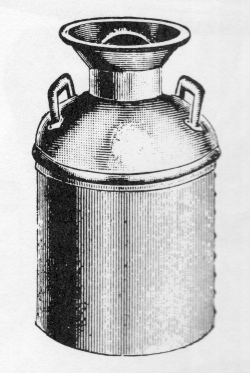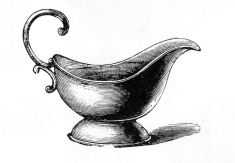A lament for white sauce
 White sauce is a preparation as despised when described in English as it once was esteemed when described as salsa bianca and balsamella in Italian or béchamel in French. The Italians make a claim of origin and they probably are right in terms of first use: According to Giuliano Bugialli,
White sauce is a preparation as despised when described in English as it once was esteemed when described as salsa bianca and balsamella in Italian or béchamel in French. The Italians make a claim of origin and they probably are right in terms of first use: According to Giuliano Bugialli,
“Italian cooking shares with French not only balsamella, called béchamel in France, but also the basic sauce called salsa bianca, in which broth substitutes for the milk of balsamella. Florentine scholars count these sauces among the simple colle, or binders, that Caterina de Medici’s cooks took to France.” (Bugialli 53)
One of her cooks, Pantanelli, had arrived in France by 1533. Bugialli also notes of balsamella that “[alt]hough this sauce was given the name béchamel by the French in the eighteenth century, it probably existed long before that in Italy. The fifteenth-century recipe for crema di miglio fritta starts with a technique very close to this.” (Bugialli 52-53)
In this instance, however, chronology begs the question of originality. The preparation of white sauce is virtually intuitive and the sauce itself appears in all western cuisines for disparate uses. The Editor doubts that it spread in tendrils like the passage of homo sapiens out of Africa; it is not a life form so its spontaneous generation on multiple fronts is plausible and, to her, likely. Versions were made in England at least as early as the eighteenth century and were called ‘white sauce’ rather than something fancified. Both Mrs. Glasse and Mrs. Raffald, for example, offer sauces in which stock is thickened by a raw roux of butter mashed with flour. These floured sauces have shared the English kitchen for centuries with white sauces fortified with cream and often egg yolks.
 In any event, automatically to ascribe something’s country of origin to the language that commonly describes it would be imprudent, nowhere more than in the realm of food. The French language is a serial plagiarist, in part due to the nineteenth century British vogue for ascribing French names to preparations from any source; thus, the old English manuscripts and cookbooks refer to Dutch instead of Hollandaise sauce. Mrs. Acton published a recipe with the traditional ‘Dutch’ usage as late as 1855. (Acton 110-111)
In any event, automatically to ascribe something’s country of origin to the language that commonly describes it would be imprudent, nowhere more than in the realm of food. The French language is a serial plagiarist, in part due to the nineteenth century British vogue for ascribing French names to preparations from any source; thus, the old English manuscripts and cookbooks refer to Dutch instead of Hollandaise sauce. Mrs. Acton published a recipe with the traditional ‘Dutch’ usage as late as 1855. (Acton 110-111)
Espagnole sauce provides another example of misdirectional nomencature because neither the name nor its rendition in French necessarily reflects its origin, which is British or French depending on your source. According to the (admittedly raffish) Countess Morphy, when eighteenth century Britons thought of this sauce they thought of a principal ingredient, ham, and when they thought of ham they thought that Spanish hams were best.
An analogous phenomenon arose in southwest Louisiana, where Donald Link and others maintain that many foods of German derivation have French names only because of the region’s lingua franca. According to Mimi Read, for example, “[s]ome historians believe Germans introduced sausages to Cajun cooking, though all those sausages were eventually rechristened with mellifluous French names.” (Read) They have a point; smoky, coarse-cut Cajun andouille has a distinct Germanic stamp and bears no resemblance to its intestinally funky, almost emulsified French namesake.
Inversions appear too. The Chicken Florentine made with spinach that is familiar to most Americans probably has its origin in Renaissance France, where the Medici brought fashions as well as cooks with them from Tuscany; giving something an Italian name gave it cachet. The Chicken Florentine cooked in Florence, however, is a dish made with artichokes. (Bugialli 292-93)
Butter, flour and milk or stock are all you need for a basic white sauce; herbs and other additions may change the name, at least in Italian or French, but do not alter the concept. Mrs. Acton includes recipes for both ‘English White Sauce’ and ‘Very Common White Sauce;’ both are thickened with butter and flour. The first uses both stock and cream as well as lemon rind and mace, while the second adds more cream, lemon juice, mashed chicken liver and parsley as well. (Acton 110) The citrus and mace make these sauces prototypically English. She also has instructions for ‘Bechamel,’ which she considers “the best kind of white sauce” and ‘Bechamel Maigre, A Cheap White Sauce’ that is “made entirely without meat, when economy [or, these days, fashion] is an object.” (Acton 106-07)

Similarly, in their Italian recipes, Johanne Killeen and George Germon do not distinguish between white sauces containing milk or stock, or those infused with herbs; all of them are styled ‘bechamel.’
To describe white sauce as versatile is to employ the trope of understatement. The sauce does service as accompaniment (poured over something like ham or broccoli), element (such as a layer of lasagne) or binder (for the fillings of steamed puddings or savory pies). It probably has other uses too. So please reconsider the use of white sauce; flour should not be considered reflexively foul.
In his Grand Dictionnaire de Cuisine, Alexandre Dumas maintains that a cook who has not mastered sauce is not much of a cook at all and in his discussion of Dumas, Andre Simon gives pride of place to white sauce. (Simon & Howe 339) Dumas was no dilettante; his dinners were legendary, he took pains to prove that he cooked them himself, and died thinking that his legacy would depend on food and the Dictionnaire rather than his novels.
Fashion changed, however; people are reading The Count of Monte Christo again and a dwindling minority of them can turn out a competent white sauce, although most would have no motivation to do so anyway. To many of them, the concept is anathema; they consider white sauce about as far removed from the Mediterranean, from California cuisine or ‘light’ cooking’, as a body could travel. Our ‘creative’ chefs disdain it, the conventional wisdom about British food deplores it and the glossy food magazines ignore it. Of course, bad white sauce is as revolting as anything else made badly, and overuse will kill the appeal of the best preparation. Dana DiMuro, the noted art director based in Montclair, New Jersey, groans when a pitcher of white sauce appears at table, and for good reason. Her husband and his family share the widespread addiction of Irish home kitchens to white sauce: “They put it on everything.” (DiMuro)
Good white sauce judiciously rationed is another matter. It should be silken and need not be thick unless you need it for heft as a binder. To lighten it up, merely increase the proportion of liquid; it is good finished with a little cream just prior to service.
The two most common pitfalls to making the sauce, lumps and separation or curdling, are easy to avoid. Use Wondra to avoid lumping; it is a cooked flour with alchemical properties, and while the enterprisingly incompetent cook could create a lumpy sauce with it, the task is arduous. Heat your stock or scald your milk to avoid separation or curdling; flour is a lot more forgiving than egg yolk, which wants to scramble and wreck your sauce. The Editor finds that a wire whisk wrists circles around a wooden spoon for white sauce.
Here is Mrs. Acton’s English white sauce:
“Boil softly in half a pint of well-flavoured pale veal gravy a few very thin strips of fresh lemon-rind, for just sufficient time to give flavour to it; stir in a thickening of arrow-root, or of flour and butter, add salt if needed, and mix with the gravy a quarter of a pint of boiling cream....
Good pale veal gravy, ½ pint; third of 1 lemon-rind; 15 to 20 minutes. Freshly pounded mace, third of a saltspoonful; butter, 1 to 2 oz.; flour, 1 teaspoonful; (or arrow-root in equal quantity; cream, ¼ pint.” (Acton 110)
Mrs. Acton forgot to include the mace in her narrative; add between ¼ and ½ teaspoonful with the peel. Also in terms of modern measurement, use a Tablespoon of flour for each one of butter, one of each for a thinner table sauce, two for use in binding other ingredients. Please note that Mrs. Acton wrote before the advent of imperial measures and therefore used 16 oz pints.
More recipes for white sauce and some of its variations appear in the shrimp pudding recipe chain of the practical.
Sources.
Eliza Acton, Modern Cookery for Private Families (London 1855; Southover Press facsimile edition 1994)
Giuliano Bugialli, The Fine Art of Italian Cooking (New York 1977)
Dana DiMuro, Interview with the Editor (St. Patrick’s weekend 2006)
Hannah Glasse, The Art of Cookery Made Plain and Easy (London 1747)
Johanne Killeen and George Germon, On Top of Spaghetti (New York 2006)
Donald Link with Paula Disbrowe, Real Cajun (New York 2009)
Countess Morphy, Mushroom Cookery (London 1954)
Elizabeth Raffald, The Experienced English Housekeeper (Manchester 1769)
Mimi Read, “Real Cajun Food, From Swamp to City,” The New York Times (20 January 2009)
Andre Simon & Robin Howe, Dictionary of Gastronomy (London 1970)

